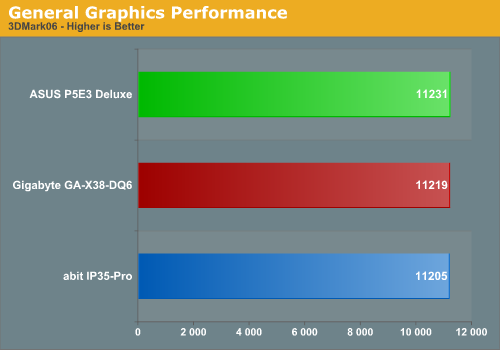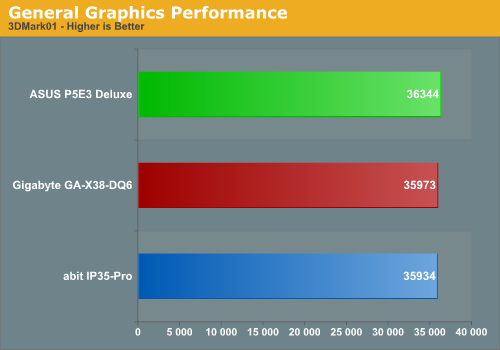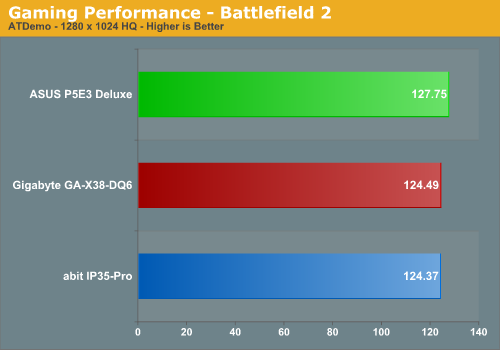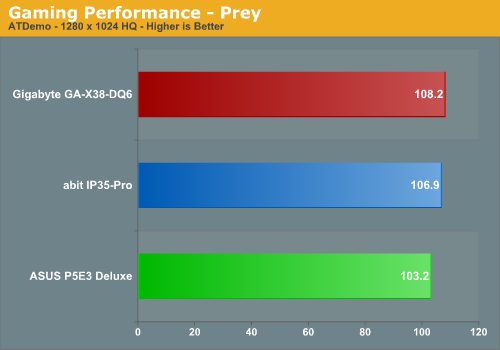ASUS P5E3 Deluxe: X38 and DDR3 arrives... almost
by Gary Key on September 18, 2007 4:00 AM EST- Posted in
- Motherboards
Gaming and Graphics Performance
The 3DMark series of benchmarks developed and provided by Futuremark are among the most widely used tools for benchmark reporting and comparisons. Although the benchmarks are very useful for providing apples-to-apples comparisons across a broad array of GPU and CPU configurations, they are not a substitute for actual application and gaming benchmarks. In this sense we consider the 3DMark benchmarks to be purely synthetic in nature but still valuable for providing consistent measurements of performance.


In our 3DMark06 test, all of the boards are basically even in this test. When looking at the individual tests, the ASUS board scores slightly better in the SM2.0 and SM3.0 tests while the CPU scores are just about identical between all three boards - we'll ignore the ASUS board's seven point advantage.
In the more memory and CPU throughput sensitive 3DMark01 benchmark we see our ASUS P5E3 Deluxe board is around 1% faster. We believe Gigabyte still has some tuning left to complete with their DDR2 X38 board as it scored a fairly anemic 35311 with the memory set to DDR2-800 with 3-4-3-9 1T timings. The differences in performance are not really noticeable in either 3DMark unless you're looking to reach the top of the ORB, which we have a good feeling the X38 was designed to do with the right setup.
Gaming Performance
As usual, gaming performance was tested with a couple popular games. We ran our benchmarks at a 1280x1024 resolution with high quality settings
Battlefield 2
This benchmark is performed using DICE's built-in demo playback functionality with additional capture capabilities designed in house. During the benchmark, the camera switches between players and vehicles in order to capture the most action possible. There is a significant amount of smoke, explosions, and vehicle usage as this a very GPU intensive Battlefield 2 benchmark. We run Battlefield 2 using medium quality graphics settings available in the video settings. The game itself is best experienced with average in-game frame rates of 35 and up.

Prey
Prey offers some superb action sequences, unique weapons and characters, and is a visually stunning game at times. It still requires a very good GPU to run it with all of the eye candy turned on. We set all graphic settings to their maximum except for AA/AF and utilize a custom timedemo that takes place during one of the more action oriented sequences. We generally find the game to be enjoyable with an average frame rate above 35fps.

Gaming Summary
The ASUS P5E3 provides an almost 3% improvement in frame rates under BF2, which tends to be more CPU limited than most games, but in the latency sensitive Prey benchmark we find it falls about 5% behind the Gigabyte board. This is the only benchmark where we witnessed a measurable decrease in performance when utilizing DDR3 at 1066 on the X38 chipset. For now, we will chalk it up to the BIOS needing fine tuning as other latency sensitive benchmarks did not show this pattern in offline testing. Once we receive the shipping BIOS for the retail boards, we will revisit these same games and provide CrossFire results against the P35 and 975X equipped boards. However, the preliminary CrossFire results show minimal gains for the X38 over the 975X when comparing percentage increases between single and dual card configurations.
The 3DMark series of benchmarks developed and provided by Futuremark are among the most widely used tools for benchmark reporting and comparisons. Although the benchmarks are very useful for providing apples-to-apples comparisons across a broad array of GPU and CPU configurations, they are not a substitute for actual application and gaming benchmarks. In this sense we consider the 3DMark benchmarks to be purely synthetic in nature but still valuable for providing consistent measurements of performance.


In our 3DMark06 test, all of the boards are basically even in this test. When looking at the individual tests, the ASUS board scores slightly better in the SM2.0 and SM3.0 tests while the CPU scores are just about identical between all three boards - we'll ignore the ASUS board's seven point advantage.
In the more memory and CPU throughput sensitive 3DMark01 benchmark we see our ASUS P5E3 Deluxe board is around 1% faster. We believe Gigabyte still has some tuning left to complete with their DDR2 X38 board as it scored a fairly anemic 35311 with the memory set to DDR2-800 with 3-4-3-9 1T timings. The differences in performance are not really noticeable in either 3DMark unless you're looking to reach the top of the ORB, which we have a good feeling the X38 was designed to do with the right setup.
Gaming Performance
As usual, gaming performance was tested with a couple popular games. We ran our benchmarks at a 1280x1024 resolution with high quality settings
Battlefield 2
This benchmark is performed using DICE's built-in demo playback functionality with additional capture capabilities designed in house. During the benchmark, the camera switches between players and vehicles in order to capture the most action possible. There is a significant amount of smoke, explosions, and vehicle usage as this a very GPU intensive Battlefield 2 benchmark. We run Battlefield 2 using medium quality graphics settings available in the video settings. The game itself is best experienced with average in-game frame rates of 35 and up.

Prey
Prey offers some superb action sequences, unique weapons and characters, and is a visually stunning game at times. It still requires a very good GPU to run it with all of the eye candy turned on. We set all graphic settings to their maximum except for AA/AF and utilize a custom timedemo that takes place during one of the more action oriented sequences. We generally find the game to be enjoyable with an average frame rate above 35fps.

Gaming Summary
The ASUS P5E3 provides an almost 3% improvement in frame rates under BF2, which tends to be more CPU limited than most games, but in the latency sensitive Prey benchmark we find it falls about 5% behind the Gigabyte board. This is the only benchmark where we witnessed a measurable decrease in performance when utilizing DDR3 at 1066 on the X38 chipset. For now, we will chalk it up to the BIOS needing fine tuning as other latency sensitive benchmarks did not show this pattern in offline testing. Once we receive the shipping BIOS for the retail boards, we will revisit these same games and provide CrossFire results against the P35 and 975X equipped boards. However, the preliminary CrossFire results show minimal gains for the X38 over the 975X when comparing percentage increases between single and dual card configurations.










60 Comments
View All Comments
tiggerjedi - Saturday, December 15, 2007 - link
Can you use DDR2 on the P5E3 Deluxe too or are you restricted to using only DDR3 with this motherboard?Deusfaux - Friday, September 21, 2007 - link
Something with features like the remote?chipsetguy - Wednesday, September 19, 2007 - link
Some notes on Bearlake-XIt has 2 Gen2 (5Gbps) x16 PCIE slots - 32 lanes off of the north-bridge
There are of course the 1x4 (or 4 x1's) on the south bridge - these are gen1. (ICH9)
There is a hardware prefetcher to help decrease memory latency (CPU -> DRAM reads)
It natively will support 1600/1600 (X48 version).
Support for new 45nm CPU's (single quad core)
With new DDR3 already at 1800Mhz, its going to really fly!
chipsetguy - Wednesday, September 19, 2007 - link
Guys - all a G35 is a re-packaged 965p - with support for fsb 1333. You guys are funny.8steve8 - Monday, September 24, 2007 - link
the g35 is not a rehashed g33 or g965your statement is false or at least misleading..
chipsetguy - Wednesday, September 19, 2007 - link
My bad - is a G965. Of course it has internal graphics... My bad.Jodiuh - Wednesday, September 19, 2007 - link
"...but then again we do not express any love for several board manufacturers who tend to use the entire Crayola color palette on their boards."THANK YOU!! I sincerely hope the hippies @ Gigacolor hear about/read this. What is so hard about using 3 colors like the DFI Dark, eh?
Jod
457R4LDR34DKN07 - Wednesday, September 19, 2007 - link
Where is the Maximus Formula SE/Xtreame? The only thing this has really got going for it is eSata.Gary Key - Wednesday, September 19, 2007 - link
The R.O.G. boards will probably be released in November. ASUS is trying to pull the date in but we do not have a final schedule, yet.larson0699 - Tuesday, September 18, 2007 - link
What about disabling prefetch/superfetch, if not also a few services?